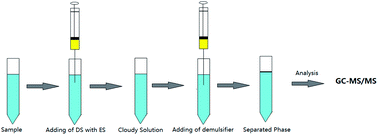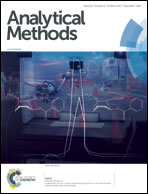Binary mixed solvent-based solvent demulsification-dispersive liquid-liquid microextraction coupled with gas chromatography-tandem mass spectrometry in determination of polycyclic aromatic hydrocarbons in water samples
Abstract
A method of binary mixed solvent-based solvent demulsification dispersive liquid-liquid microextraction coupled with gas chromatography-tandem mass spectrometry (GC-MS/MS) was developed for the determination of polycyclic aromatic hydrocarbons (PAHs) in water samples. A binary mixed solvent of methylene chloride and n-hexane (v/v = 1 : 1) which has a lower density than water was used as the extraction solvent, obtaining satisfactory extraction efficiencies for PAHs, and also allowing convenient operation. Acetonitrile as the dispersive solvent was injected into the water sample solution to form an emulsion. The extraction can be completed in 5 min and ethanol was used as the demulsification solvent to bring about successful phase separation without centrifugation. Coupled with GC-MS/MS analysis, the method was simple, sensitive, accurate and suitable for batch analysis of PAHs in water samples. Good linearity was obtained within the linear range for 16 PAH compounds, with determination coefficients from 0.9980 to 0.9998. This method can be used to effectively evaluate the situation of PAH pollution in water intended for human consumption and environmental water, the method detection limits (MDLs) of which were 2.1 to 13.6 ng L−1 and only 20 mL of water samples were used for analysis. The proposed method was applied to determine PAHs in actual water samples including tap water, and the upper, middle and lower reaches of the Jinjiang river in Chengdu city. Meanwhile, spiked samples and procedural blanks were used for quality control measurements according to ISO/TS 13530-2009 to guarantee the accuracy of this method. The average spiked recoveries of PAHs were in the range of 85.0–104% with RSDs in the range of 5.8–10.9%. Naphthalene, acenaphthylene, acenaphthene, fluorene, phenanthrene, fluoranthene and pyrene were predominantly measured, and PAH pollution was found at the total concentrations of 0.162–0.206 μg L−1 in the Jinjiang river of Chengdu city of P. R. China. Considering their toxicity, attention should be paid to water pollution by PAHs and necessary monitoring should be done.



 Please wait while we load your content...
Please wait while we load your content...